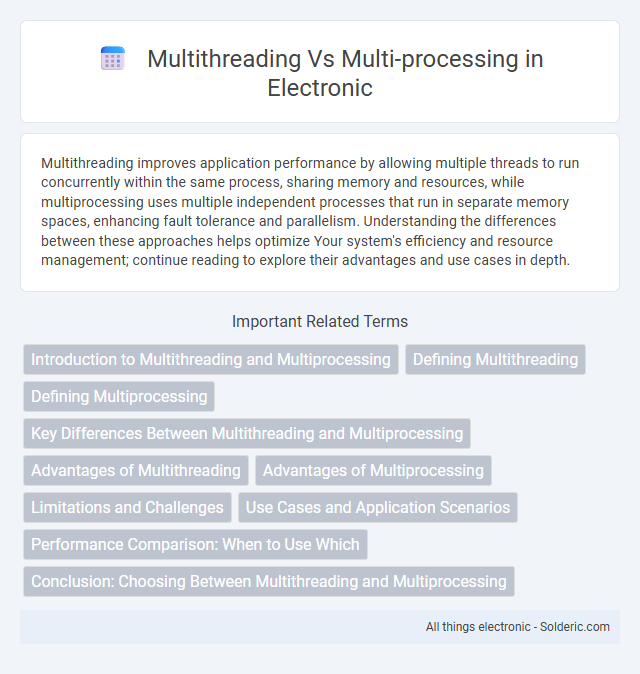Multithreading improves application performance by allowing multiple threads to run concurrently within the same process, sharing memory and resources, while multiprocessing uses multiple independent processes that run in separate memory spaces, enhancing fault tolerance and parallelism. Understanding the differences between these approaches helps optimize Your system's efficiency and resource management; continue reading to explore their advantages and use cases in depth.
Comparison Table
| Feature | Multithreading | Multiprocessing |
|---|---|---|
| Definition | Multiple threads within a single process share memory and resources. | Multiple processes run independently with separate memory spaces. |
| Memory Usage | Lower memory consumption due to shared address space. | Higher memory usage because each process has its own memory. |
| Communication | Fast and easy via shared memory. | Slower, requires IPC mechanisms like pipes or sockets. |
| Performance | Efficient for I/O-bound tasks, limited by Global Interpreter Lock (GIL) in some languages. | Better for CPU-bound tasks, can run on multiple CPUs or cores simultaneously. |
| Fault Isolation | Less fault tolerant; one thread crash can affect entire process. | More robust; process failure typically isolated. |
| Context Switching | Lower overhead due to threads sharing process resources. | Higher overhead due to separate process contexts. |
| Use Case | Suitable for lightweight, concurrent tasks within application. | Ideal for heavy, parallel computations requiring isolation. |
Introduction to Multithreading and Multiprocessing
Multithreading allows multiple threads to run concurrently within a single process, sharing the same memory space to improve application efficiency and responsiveness. Multiprocessing involves running multiple processes simultaneously, each with its own memory space, which enhances performance for CPU-bound tasks by leveraging multiple CPU cores. Understanding the differences between multithreading and multiprocessing helps you optimize resource utilization based on the specific needs of your applications.
Defining Multithreading
Multithreading refers to a programming technique where multiple threads run concurrently within a single process, sharing the same memory space to improve application performance and responsiveness. Each thread represents a lightweight unit of execution that can handle tasks independently while coordinating access to shared resources, enabling efficient parallelism on multi-core processors. This approach reduces the overhead associated with creating multiple processes and allows faster context switching compared to multiprocessing.
Defining Multiprocessing
Multiprocessing refers to the ability of a system to run multiple processes simultaneously, each with its own memory space and resources, improving overall CPU utilization and performance. It enables parallel execution by distributing tasks across multiple processors or cores, enhancing efficiency for CPU-bound operations. Unlike multithreading, multiprocessing avoids shared memory conflicts since processes operate independently, making it ideal for heavy computational workloads.
Key Differences Between Multithreading and Multiprocessing
Multithreading involves multiple threads running within a single process, sharing the same memory space, enabling efficient communication but risking data conflicts. Multiprocessing runs multiple processes independently, each with separate memory, improving fault isolation and leveraging multiple CPUs for parallelism. Threads are lightweight with lower context-switching overhead, while processes offer better stability and scalability in handling separate tasks.
Advantages of Multithreading
Multithreading improves application performance by allowing multiple threads to run concurrently within a single process, sharing the same memory space for faster data access and communication. Your program benefits from reduced context-switching overhead compared to multiprocessing, which enhances CPU utilization and responsiveness. This design also leads to lower resource consumption and faster execution, especially in I/O-bound and interactive applications.
Advantages of Multiprocessing
Multiprocessing enhances performance by enabling parallel execution of multiple processes across different CPU cores, leading to better CPU utilization and faster task completion. It provides improved fault isolation, as each process runs independently, reducing the risk of system crashes caused by individual process failures. Multiprocessing also supports true concurrent execution, making it ideal for CPU-intensive applications that require heavy computation.
Limitations and Challenges
Multithreading faces limitations such as difficulty in managing thread synchronization, which can lead to race conditions and deadlocks, impacting program stability. Multi-processing, while providing true parallelism by using separate memory spaces, has challenges including higher memory consumption and overhead from inter-process communication (IPC). Both approaches encounter difficulties in debugging and resource allocation, requiring careful design to optimize performance and avoid bottlenecks.
Use Cases and Application Scenarios
Multithreading is ideal for applications requiring concurrent tasks that share memory space, such as real-time gaming, UI responsiveness, and lightweight I/O operations. Multi-processing excels in CPU-bound tasks that need isolated memory, including scientific simulations, data analysis, and heavy computational workloads. Your choice depends on whether you prioritize shared resources and communication speed (multithreading) or fault isolation and parallel execution (multi-processing).
Performance Comparison: When to Use Which
Multithreading excels in scenarios requiring lightweight, concurrent tasks with shared memory access, offering faster context switching and lower overhead, ideal for I/O-bound and real-time applications. Multiprocessing leverages multiple CPU cores for true parallelism, preferred for CPU-intensive workloads that demand isolated memory spaces to avoid race conditions. Choosing between multithreading and multiprocessing depends on performance needs, resource utilization, and the nature of the task's computational or I/O demands.
Conclusion: Choosing Between Multithreading and Multiprocessing
Choosing between multithreading and multiprocessing depends on the nature of the task and system architecture. Multithreading excels in I/O-bound operations and environments requiring shared memory with low overhead, while multiprocessing is better suited for CPU-bound tasks benefiting from parallel execution across multiple cores. Evaluating factors such as task concurrency, resource contention, and inter-process communication overhead is crucial for optimizing performance and scalability.
Multithreading vs Multi-processing Infographic

 solderic.com
solderic.com